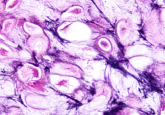It’s a match! RNA sequencing and the future of oncology management

Researchers have demonstrated that RNA sequencing could be useful in accurate genetic profiling of tumors to guide successful targeted cancer treatments.
Accurately diagnosing cancer at an early stage is key to devising successful treatment plans and reducing cancer-related mortality. Consequentially, over recent years there has been an effort to advance molecular profiling of tumors.
Cancer arises through a combination of genetic changes and mutations, unique to that individual patient, meaning that every patient is different. Genetic tumor profiling can be utilized in the clinic to identify these mutations and provide potential targets for treatment.
Like many areas of medicine, oncology management has bloomed in the era of precision medicine. It is now widely accepted that successful, targeted cancer treatment plans should be tailored to the mutational changes in the tumor as opposed to the type and stage of the cancer.
This has been met with a subsequent rise in genomic tumor profiling, most commonly through DNA sequencing. DNA sequencing is utilized in the clinic to determine which mutations an individual patient’s tumor has experienced, which allows clinicians to devise a targeted treatment plan.
RNA sequencing, although so far having a considerably smaller role in the clinic, has also been demonstrated to be a useful tool for cancer diagnosis and targeted therapy, either alone or complementary to DNA sequencing.
Incorporating RNA sequencing in the clinic
Although DNA sequencing has proved useful in the clinic, RNA sequencing provides novel opportunities to obtain a vast amount of information on previously unidentified changes in the genome of cancerous tumors.
RNA sequencing allows clinicians to profile the composition and abundance of the entire transcriptome, including mRNA and non-coding RNA. This means that, rather than just revealing the specific mutations, RNA sequencing can reveal a wide range of functional and structural changes experienced by genes.
Unlike DNA sequencing techniques, RNA sequencing can measure gene expression and detect point mutations and small indels. This information can aid in understanding tumor classification and progression, and consequentially would allow for more specific and accurate cancer diagnosis.
Additionally, the information gained from RNA sequencing analyses of tumors can be utilized to predict how a patient will respond to specific treatments. In this way, RNA sequencing can be used to aid and inform treatment decisions.
In a recent interview with Targeted Oncology at the 2019 Association for Molecular Pathology Annual Meeting and Expo (7-9 November; Baltimore, MD, USA), Kevin Halling (Mayo Clinic, MN, USA) explained how, since so much information can be gained from a single test with RNA sequencing, it will provide clinicians with much better value for money than DNA sequencing.
According to Halling, RNA sequencing in the clinic can be considered a ‘powerful diagnostic technique’ and he claims that the clinical utility of this method will continue to expand alongside the development of the technique in laboratories.
Superior detection of fusion genes
Halling’s main work with RNA sequencing focuses on its ability to accurately detect fusion genes. This application has already been explored in reasonable detail, with a lot of effort being put into evaluating and improving this method.
Fusion genes are a major cause of cancer and account for approximately 20% of human cancer morbidity. They are hybrid genes that usually arise from chromosomal rearrangements that place two different genes together, such as translocation, interstitial deletion and chromosomal insertion..
Identifying these fusion genes provides opportunities for targeted treatment, with several fusion gene inhibitors having already been successfully developed. Furthermore, fusion gene diagnosis has been shown to allow for a more accurate prediction of patient prognosis, survival and treatment response.
Current detection methods, such as fluorescence in situ hybridization (FISH) and quantitative real-time PCR, are often laborious, time-consuming and expensive. Furthermore, they are unable to identify novel fusion gene partners or resolve complex structural rearrangements, therefore often result in false-negative results.
In a study, published earlier this year in Nature Communications, researchers from the Garvan Institute for Medical Research (Sydney, Australia) demonstrated that RNA sequencing can accurately detect fusion genes and overcome the limitations of current methods.
The researchers discovered that RNA sequencing detected fusion genes more accurately than FISH analysis and also identified 20% more fusion genes that were not detected with FISH. This demonstrated that RNA sequencing could considerably improve the diagnosis rate of fusion genes.
“Rather than just being a research project, this method has direct application for cancer patients,” explained senior author Jim Blackburn. “We want to help make diagnosing patients more accurate and more efficient so that they can receive the right treatments faster.”
- HPV-RNA Seq: a powerful diagnostic technique for cervical cancer?
- RNA Sequencing; as accurate as once believed?
- Could photothermal therapy become the ‘gold standard’ of cancer treatment?
What about the children?
As well as providing more detailed information on a tumor’s genetic changes, RNA sequencing could provide an option to tailor treatments for more difficult to treat cases, such as those where genetic information is harder to acquire.
In particular, researchers have considered the role of RNA sequencing for pediatric cancer cases. Many tumors in children do not possess actionable DNA aberrations so DNA sequencing is not an option when devising targeting treatments.
A recent study, published in JAMA Network Open, evaluated the feasibility and usefulness of comparative RNA sequencing analyses of pediatric tumors across four different precision medicine studies.
“In pediatric cancer, it often isn’t a DNA mutation driving the cancer but an error in development caused by a change in how gene expression is regulated,” explained corresponding author Olena Vaske (University of California, Santa Cruz, CA, USA). “We showed for the first time that this framework can be used consistently across separate precision medicine clinical trials.”
RNA sequencing data was obtained for 144 tumor samples from 128 pediatric cancer patients from four clinically different precision medicine trial databases. They then conducted a secondary analysis of the tumor data to evaluate whether or not RNA sequencing is useful.
The researchers discovered that RNA sequencing analysis was feasible and useful for 99 of the 144 (69%) samples considered. On the other hand, DNA sequencing analysis was potentially useful for only 34 of 74 samples (46%).
Whilst further research is required to evaluate the clinical utility of this approach, these results suggest that RNA sequencing provides a novel opportunity to enhance precision medicine in pediatric cancer.
The future of RNA sequencing
Numerous studies have demonstrated the potential benefits of utilizing RNA sequencing technology for cancer diagnosis. Applying these to the clinic could aid in proving accurate diagnoses, which should in turn help to the burden of cancer.
Therefore, we can expect to see a rise in the use of RNA sequencing in the clinic in the future. For now, more research is needed to understand the true potential of RNA sequencing before it can be fully adopted by clinicians.
Despite this, the findings so far indicate that RNA sequencing could be the key to paving the way for successful precision medicine in oncology management and provide a positive outlook for the future of cancer treatments.
Want to find out more about RNA sequencing in cancer research? Visit our In Focus on RNA sequencing for cancer research, where you can get top tips for RNA sequencing library preparation in the In Focus Infographic here and after our video introducing the topic here!





